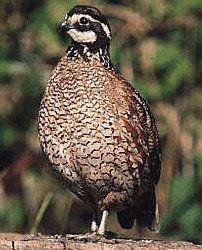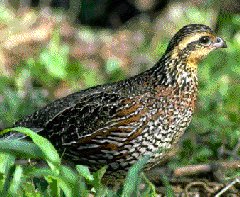Bird Dogs...
Quail...
Resources...
Library...
Dog Training Collars
Tri-Tronics
SportDog
Dogtra
Innotek
| Click on the player to hear the two-tone call of the bobwhite |
Bobwhite Basics
Being a site devoted to all things quail, it would be remiss if lacking a few fundamentals of this persevering bird. Further down the page, I've included some links that you can follow to more detailed discussions of the ins and outs of this particular breed of quail.
Colinus Virginianus as the bobwhite is known to the National Geographic crowd, is a small, ground-dwelling member of the avian species. Weighing only five or six ounces as full-grown adults, the birds command respect not because of their impressive size but rather for their crafty survival instincts. Male and female are differentiated by the coloring on their faces; males have a white masking while females have a brownish-yellow tint in the same area.
 |
 |
| male bobwhite | female bobwhite |
Where do they live?
Although occasionally seen roosting in trees (to the dismay of hunters), bobwhites spend most of their lives on the ground. Except during breeding season, they travel in groups, or "coveys", of anywhere from five to thirty birds which roam areas of twenty to forty acres. They eat, sleep, and build their nests on the ground, and typically only take to the air when threatened by predators.They prefer ground in what foresters call the "early successional growth" phase, which in simple terms is ground that has been burned or plowed in the last three years. The short, succulent vegetation that appears during this period satisfies their food and shelter needs quite well and is the reason that most hunting plantations burn parts of their land every two to three years.
Small fields surrounded by thick hedgerows are ideal neighborhoods, as they provide easy access to food as well as nearby cover from predators. Many southern pine forests which are properly thinned also satisfy the need for nutrition, nesting habitat, and protection from other animals that find quail a delicacy.
What do they eat?
The diets of quail chicks and adult quail are quite different. During the first few weeks of their lives, quail depend primarily on small insects for their breakfast, lunch and dinner. Habitat that is rich with these bugs is essential to maintaining healthy quail populations.As they grow older, the staple of their diet moves to seeds. Wheat, millet, lespedeza, sorghum, and corn fill the plate of many a quail, but other seeds that aren't commonly thought of as "food" also contribute. Beggar's lice, sometimes called hitchikers, the seeds from sweet gum balls, partridgepeas and many other weeds and plants round out their diet.
What purpose does the covey serve?
Although some would say the covey exists to provide hunters with a thrill matched maybe by skydiving, the clusters of quail we encounter in the woods actually serve a much more practical purpose.Following the "strength in numbers" theory, quail travel together to help protect each other. Forty eyes on the lookout are many times more effective than two, and when a predator does approach, the noise and scattering of birds in a covey rise both startles and confuses him.
During the winter, a secondary benefit of the covey is warmth. Packed tightly in a bundle with the birds on the outside facing away from the center, quail on the inside of the bunch are insulated from the cold by the others in the group. They take turns, each serving his time on the cold outside as well. For this reason, coveys may be larger during the winter than in warmer months. I've heard that there is an optimum number for warmth, but the numbers I've heard range from 28-30 birds.
What about family life?
Quail are persistent breeders, and this is quite fortunate considering the adversity they face in their struggle to survive. Beginning in early- to mid-April, depending on the weather, coveys will dissolve as males and females pair off to begin nesting. Because of the lack of protection normally provided by the covey, quail are particularly vulnerable to predators during this time.The hen lays a clutch of ten to fifteen eggs at a rate of one per day. Mom and dad share the incubation duties, and if all goes well (i.e. no predators eat the parents or the eggs), the chicks appear in 23 days. If something does prevent the eggs from hatching, the pair will continue trying to raise a brood until as late as October. This innate drive to reproduce is one of the reasons that quail continue to survive in the face of colossal odds.
Seventy five to eighty percent of the birds hatched in one season will not live to see the next. This figure holds true even on a plot of land that is not hunted, which may surprise a few souls. Quail are such a delicacy to predators of the fields and forests that, for a newborn, surviving long enough to raise a brood of his own is a struggle against the odds.
This article barely scratches the surface of the collected body of knowledge on the bobwhite quail. If you're interested in reading more, the classical tome on the subject is The Bobwhite Quail, by Herbert L. Stoddard. It's hard to come by, so guard your copy if you're fortunate enough to find one. A recent release that contains a bevy of modern research is On Bobwhites by Fred Guthery. It is much more concise than Stoddard's book and even examines the accuracy of some of Stoddard's conclusions.
 Windows users press "CTRL+P" to print this page.
Windows users press "CTRL+P" to print this page.
 Mac users press "Apple/Loop+P" to print this page
Mac users press "Apple/Loop+P" to print this page